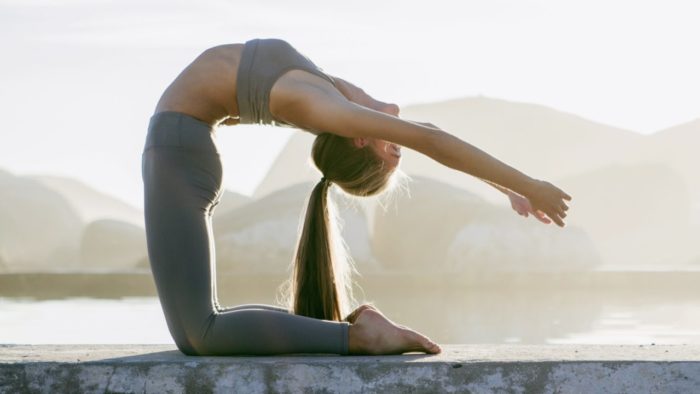Although I was initially quite interested in the idea that yoga breathing could oxygenate my body–it sounds so dreamy!–I’ve also noticed that “oxygen” and “O2” seem to be hot words it marketing these days. The oxygen trend is appearing in skin care products and snack foods and drinks. There’s even a new style of yoga called Oxygen Yoga. But can yoga really deliver more oxygen to the body? I did some research to learn more and was rather surprised by what I found out–and how little I understood the mechanisms of human breath.
Of the many claims surrounding yoga’s health benefits, the activity’s ability to “oxygenate” the body through breath work may be one of the most vaguely discussed yet deeply revered concepts in yoga. Perhaps this is because we’ve come to understand (and experience) that yoga breathing can expose us to a variety of pleasant feelings from heightened awareness to mental calm. Yoga’s relationship with oxygen intake is often misunderstood, however. This is not to say that yoga breath work or mindful breathing is void of any benefits—the opposite is true!—rather, the good feelings you experience from yoga breathing don’t necessarily have to do with oxygenation.

Your Body and Oxygen
Thanks to hemoglobin, a protein in red blood cells, our lungs and tissues get a steady supply of oxygen. When hemoglobin is refreshed with oxygen, it’s typically 97% saturated with oxygen. That’s pretty full. Given that hemoglobin is so good at it’s job, breathing in a particular way doesn’t significantly change the oxygen levels in the bloodstream.
The efficiency with which the body absorbs oxygen isn’t absolutely set in stone, of course. Muscle activity, metabolism, and heart rate all influence the body’s oxygen content. (And yoga, or any style of exercise, may play a role in all three of those.) But the question remains: If yoga breath work doesn’t really oxygenate the body any more than regular breathing, then why does yoga breathing make us feel like it does? The answer may actually lie the way breathing styles play a role in levels of carbon dioxide.
Unlike oxygen levels, the levels of carbon dioxide in the body can vary quite a bit depending on how fast or slow we breath.
Fast Yoga Breathing
“Breath of Fire” is one popular breathing exercise in which the practitioner voluntarily breathes rapidly or hyperventilates. This exercise has been associated with “clearing stagnant energy” and “awakening and oxygenating the body.” Hyperventilation, whether voluntary or involuntary doesn’t significantly increase the body’s stores of oxygen, however. Rather, it lowers the body’s levels of carbon dioxide. The effects of reduced levels of carbon dioxide include light-headedness, giddiness, and tingling in the extremities. At its worst, hyperventilation may cause a person to hallucinate or pass out. Beginners are advised to practice Breath of Fire in short increments in order to avoid the negative side effects of hyperventilation. (But now that I have a little better understanding of Breath of Fire, I’m not particularly interested in practicing it at all.)
Slow Yoga Breathing
Like quickened breathing, slowed breathing has its own physiological repercussions. “Ujjayi” is a mindful, slow breathing also known as “oceanic breath” since air passing through the throat in ujjayi sounds a bit like the ocean waves. (Even writing about that makes me feel calmer.) Slowed breathing is linked to heightened vigilance. By limiting the exhalation of carbon dioxide, slow yoga breath promotes a sense of calm and well-being according to a 2001 study. Importantly, this has nothing to do with the body’s stores of oxygen.
Take Aways
Yoga breathing alone doesn’t really oxygenate the body. But that’s okay. This research has taught me that our bodies are really good at processing oxygen, and the practice of using our muscles and generally being active supports this natural process—all the more reason to hop on your mat! As far as particular breathing styles go, approach any kind of hyperventilation with caution, and embrace that ujjayi for a little extra zen in your day.
Do you have a favorite style of yoga breathing?
More in Peaceful Practice: Does Yoga Make You More Creative?
Do Yoga Twists Really Detoxify?
Get more like this—Subscribe to our daily inspirational newsletter for exclusive content!
__
Photo: Organic 4 Greenlivings




